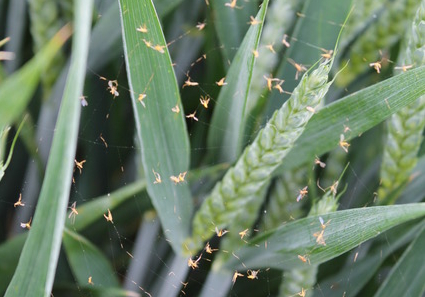ADAS Crop Action summarises winter wheat crop development as ranging from GS45 (flag leaf sheath swollen) to GS55 (half of ear emerged above the flag leaf ligule) and includes first reports of orange wheat blossom midge (owbm) hatch.
Most parts of the country experienced heavy rain over the last week of May and soil temperatures above 13oC. The coincidence of these factors trigged the start of pupation. ADAS’ Dr Steve Ellis says midges have been seen on yellow sticky traps in Norfolk and caught in cobwebs at ADAS Boxworth. “Our best advice now is to check owbm-susceptible winter wheat varieties at the susceptible growth stage (GS 51-59) for adult female midges in the evenings.”
The AHDB Cereals & Oilseeds information sheet provides guidance on monitoring for owbm with pheromone and yellow sticky traps. The control threshold in susceptible milling and seed crops is one midge per six ears and in susceptible feed crops it is one midge per three ears. But Dr Ellis points out that in practice it is very difficult to assess midge numbers per ear. “If you part the crop and a cloud of midges appears this can be considered a threshold.”
He lists the treatment options as; lambda-cyhalothrin, beta-cyfluthrin or thiacloprid. “Lambda-cyhalothrin and beta-cyfluthrin are both pyrethroids and timing is crucial as treatments kill only the adults present at the time of spraying. Thiacloprid is a neonicotinoid insecticide and as well as controlling adults has some activity against eggs and larvae. Also it has no crop edge restriction or buffer zone requirement.”
Bayer’s Neil Thompson says its insecticide Biscaya (thiacloprid) offers much greater efficacy than the pyrethroids and potentially more importantly, better timing flexibility. “You need to get the timing spot on with pyrethroids. Biscaya is more flexible, proven in IPM programmes with low impact on beneficial insects and the only option for treating the entire field.”
Yield loss to owbm can be as much as a tonne of wheat per hectare and it can have serious implications for seed and milling crops as feeding results in smaller grains with reduced germination capacity and lower Hagberg falling number.
Biscaya treatment is advised at 0.4 L/ha during ear emergence as soon as the threshold is reached. Resistant varieties do not require monitoring or treatment.




